Most often, the worms appear in preschool and elementary school children. Where do worms come from? The main cause of helminth infestation in children is poor hygiene. Toddlers do not always wash their hands, they like to put their fingers in their mouths, bite their fingernails and eat unwashed fruits and vegetables. The development of helminth infestation occurs if a person has weakened immunity. The immune system in children, once formed, is not able to deal with a large number of foreign factors. The signs of worms in children look like symptoms of poisoning or diseases of the gastrointestinal tract.
Why are worms dangerous to a child's body? They destroy the internal organs, absorb nutrients, cause inflammation. The toxins secreted by the helminths negatively affect the baby's nervous system. You can remove worms with the help of traditional and traditional medicine.
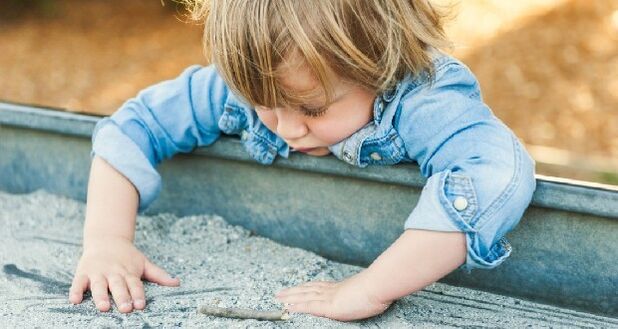
Types of helminths in children
Helminths occur quite often in children, especially in preschool age. The risk of infection is always high. The child can get an infection in kindergarten, on the playground, in contact with animals. Also, children often neglect to wash their hands after using the toilet, before eating.
What are worms? Worms are a huge group of parasitic worms. They can live in the intestines, liver, respiratory tract, some can affect the heart and brain. The main types of worms in children:
- Roundworms - the most numerous class of human parasites, include pinworms, roundworms, hookworms, trichinella.
- Movies - the category includes bovine and pork tape (tape), echinococcus.
- Tremors are biogenic vesicles, including schistosomes, posterior, grooves (liver and cat).
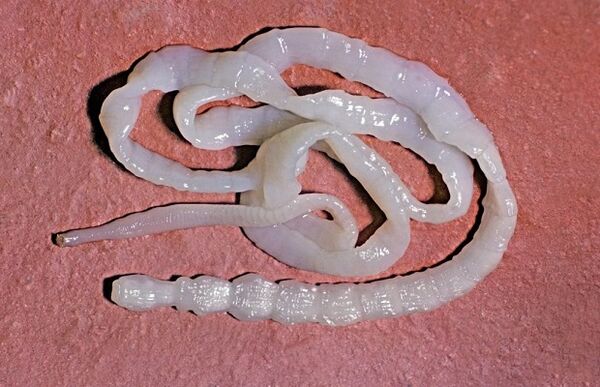
In addition, parasitic diseases are caused by protozoa (protists) - unicellular organisms; in the human gut, Giardia or amoebae are parasitic.
Diseases caused by parasites in children have different degrees of risk, but they have similar symptoms. The vast majority of roundworms infest the gastrointestinal tract, are found in the contents of the duodenum, in the feces. The food source for worms is digested food (most often carbohydrates), sometimes blood. Helminthiasis in children has symptoms similar to an eating disorder or gastrointestinal disease.
The most common types of helminths in children
Children are much more prone to worm infestation than adults. The most common helminths in children:
- Enterobiasis (worm infection).
- Ascaris (invasion of ascaris).
- Giardiasis (invasion of giardia).
Pin worms live only in the intestines. Migratory roundworm larvae enter the airways, liver and heart. Giardia very often causes diseases of the liver and gallbladder, although they can not survive in these organs. Are these diseases contagious?
Enterobiasis is transmitted from person to person by handshake, contact with household items used by the patient.
Ascariasis and mumps, under certain conditions, can also be transmitted from baby to other family members.
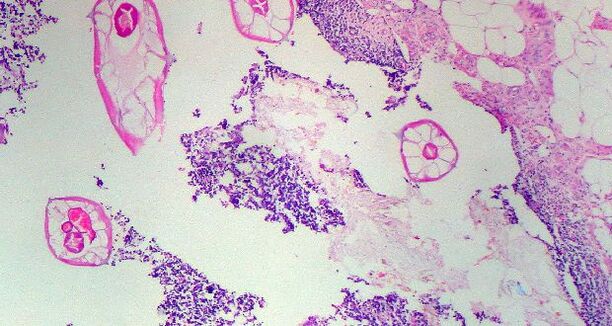
Enterobiasis
The main cause of pinworm infection is dirty hands. Also, parasitic eggs can enter the baby's body when he eats well-washed fruits. Signs of worm infection appear after 3-4 weeks from the date of infection. A characteristic sign of enterobiasis is itching in the anal area, which occurs during sleep. Unpleasant sensations are caused by the movement of female worms, which crawl out to lay eggs. With a strong invasion, you can see the worms in the feces of a child with the naked eye.
When the baby scratches the anus and then the hands go into the mouth (something that often happens with young children), infection occurs again. Therefore, during the treatment period for helminthiasis, children should be monitored so that they wash their hands regularly and eat only well-processed foods.
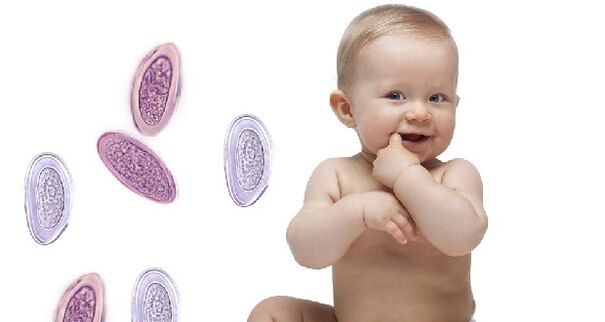
Ascaris
Roundworm infection occurs through unwashed products, insufficiently heat-treated meat, through contact with animals. The parasites enter the baby's body in the form of eggs and larvae. Eggs develop in the intestines, the larvae begin to migrate through the blood and lymphatics. They reach the liver, the right ventricle of the heart, the lungs. These organs are regularly and abundantly supplied with oxygen, which is so necessary for the larvae to grow into adults. From the lungs, the larvae will enter the bronchi, trachea, cough and swallow saliva in the stomach. The cycle of movements continues until the larva develops.
With worms in children, in addition to the typical symptoms, a severe cough may occur. Helminthiasis in children is detected using a co-program and special blood tests.
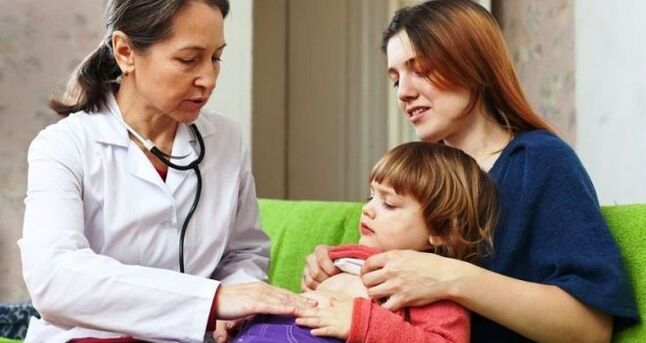
Γιαρδιάση
Giardiasis in a child develops when more than 10 cysts enter the body. The cysts are immobile, resistant to environmental conditions, a form of lamblia from which, under favorable conditions, individuals capable of reproduction develop. Movable proteins can only live in conditions created only in the human small intestine.
Stages of development of Giardia invasion in humans:
- Cysts from the oral cavity enter the stomach and then the duodenum. The protective capsule is destroyed, two Giardia are released.
- Giardia eat simple carbohydrates, multiplied by the longitudinal division of the cell in half.
- Some of the parasites pass into the large intestine, where they can only exist in the form of cysts.
- During the act of defecation, the cysts come out, penetrating the external environment.
Giardia cysts can be found in water, vegetables, fruits, meat, household surfaces. They are very durable, difficult to destroy with conventional detergents. The risk of human-to-human transmission is low.
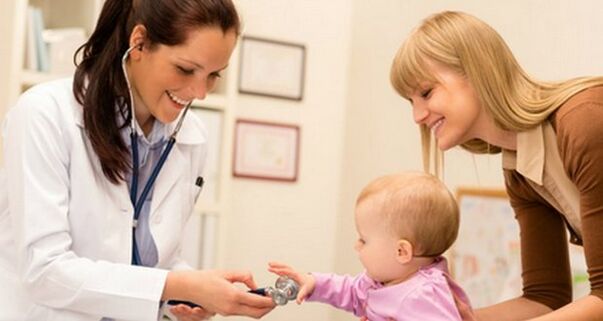
Typical symptoms of helminthiasis in children
The first signs of worms appear 2-4 weeks after infection. Worm infestation in children can occur in acute or latent form. If the parasite population is small, then the baby may not feel any discomfort.
The main symptoms of worms in children:
- Abdominal pain of different localization and intensity, manifested by epileptic seizures.
- Stool disorders, diarrhea and constipation.
- Nausea, vomiting.
- Decreased or, conversely, brutal appetite.
- Intestinal dysbacteriosis.
- Energy loss, dizziness.
- Sleep disorder.
- Dermatitis.
- Pale skin, blue circles under the eyes.
- Girls may develop urinary incontinence.
Dermatitis (rash, redness, itchy skin) is the result of an allergic reaction to the toxins released by helminths. Harmful substances also affect the state of the nervous system. Children look tired, irritable, capricious.
Acute infection is accompanied by helminth symptoms in children - fever, vomiting, diarrhea.
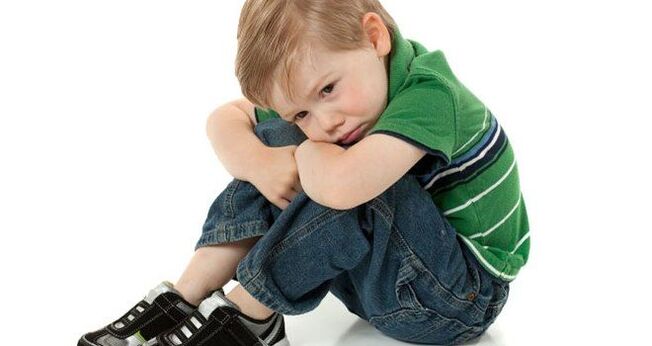
Tests for helminths in children
How to recognize worms in a child? Worm infestations in children are difficult to determine from the clinical picture. The symptoms of different helminths are similar. Detection of worms is carried out with the help of both time-tested and new laboratory diagnostic methods.
- Histological analysis of the stool allows you to check for the presence of helminth eggs in the stool.
- Microscopic abrasion examination of the anus (helps identify enterobiasis).
- Analysis of the contents of the duodenum. In the contents of the duodenum, worms or protozoa can be found.
- General blood test with leukocyte formula. Indirect signs of the presence of worms are increased levels of eosinophils and anemia.
- Serological tests for antibodies against helminthic antigens.
- Polymerase chain reaction (PCR) analysis.
PCR is the most reliable and sensitive method for the diagnosis of helminth infestations. Blood, feces, scratches are suitable for analysis. The study determines the presence of foreign DNA in a biological sample. The effectiveness of the histogram is lower than that of PCR and ELISA.
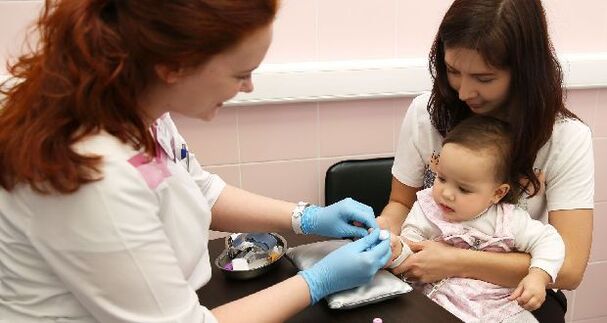
Principles of treatment of helminth infestations
How to get rid of worms in children? The method of treatment depends on the type and degree of helminthic invasion. Helminthiasis is usually treated conservatively (without surgery), but echinococcal cyst removal is performed.
The treatment of worms in children consists of several stages:
- Preparing the body for treatment.
- In fact treatment, taking anthelmintic drugs.
- Recovery of the body after illness and medication. It is necessary to normalize the function of the nervous system, to increase immunity, to get rid of intestinal dysbacteriosis.
The treatment period usually lasts about three months. Before starting treatment, you need to accurately determine if the child has worms. The treatment is prescribed and controlled by a doctor.

Drug treatment of helminths in children
A comprehensive approach will help in the complete cure of any variety of helminthiasis, without harm to the body. You can treat worms in a child using certain medicines:
- Anthelmintic drugs. They include antiparasitic drugs that differ in spectrum and principle of action. Appointed depending on the type of invasion. It will be more convenient for the baby to take the medicine in the form of a suspension.
- Absorbents. Bind toxins, accelerate the elimination of worms from the body. Only strictly prescribed doses of sorbents can be taken, otherwise severe digestive disorders may occur.
- Antiallergic agents. Helps relieve the symptoms of helminth waste allergies.
- Hepatoprotectants. Assign during the recovery period. Helps normalize liver function.
- enzyme preparations. Restore normal digestion.
In the treatment of enterobiasis, the patient is also prescribed enemas. If the baby is prone to constipation, the doctor will prescribe laxatives. It is important to have regular bowel movements so that parasites and toxins are eliminated from the body. It is impossible to take any medicine uncontrollably, as there is a possibility of side effects.
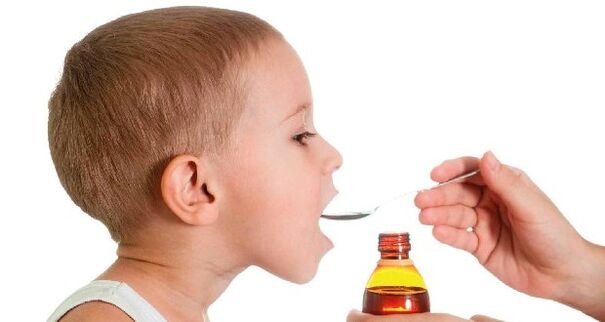
Traditional medicine for worms
Traditional medicine is not desirable for the treatment of helminthiasis in children. They do not kill the worms and do not help to remove them from the body. Folk remedies can be used only in combination with drug therapy.
How to remove worms from a child by folk methods? Here are some of the most common recipes:
- Pumpkin seed. Contains ingredients that interfere with the normal functioning of the worms, remove toxins. The peeled seeds (100 g) are crushed and poured with olive oil (100 ml). The tincture is given to the child before meals (three hours) for three days. The treatment is repeated after 2 days. Pumpkin seeds can be boiled in milk (15 seeds in 1 glass). The medicine is given to the baby to drink before lunch.
- Garlic mixture. A few cloves of garlic (2-3) should be rubbed on a fine grater, mixed with a small amount of water until smooth. For a small child, garlic is mixed with a spoonful of milk or orange juice, which is given to drink before bedtime.
- Onion in oil. 100 grams of onion are finely chopped, covered with a teaspoon of salt, pour 50 ml of sunflower oil or olive oil. The mixture is given to the baby for five consecutive days before going to bed.
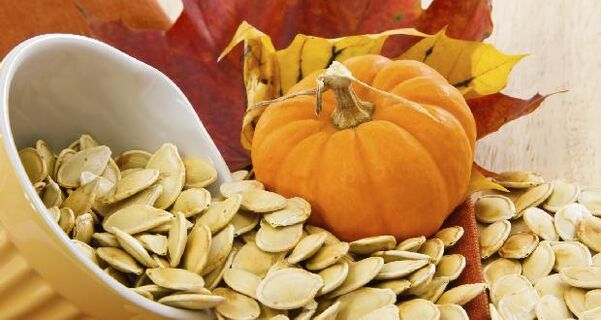
Beet-carrot juice, echinacea tincture will help increase the child's immunity. Restore the nervous system - chamomile tea. Chamomile is also used for enemas for enterobiasis.
Folk remedies are contraindicated in children with peptic ulcer, gastritis, pancreatitis, tendency to allergies. And, of course, before you start trying "grandma's recipes" on a child, first consult a pediatrician and a parasitologist, otherwise the result of such treatment may be the most unpredictable.
Nutritional supplements and homeopathy for worms
The Internet is full of advertisements for biologically active additives (BAAs) and homeopathic remedies, which, according to the manufacturers, will completely remove the worms. The reviews for the funds are extremely positive.
Why can't diet supplements be used to treat worms in a child? Biologically active dietary supplements help normalize metabolism, increase the body's resistance, improve the function of internal organs, but do not get rid of parasites. They can only be used in combination with traditional medicines.
Homeopathic remedies consist of a complex of natural extracts. They also do not have a detrimental effect on worms. But they can increase immunity, restore metabolism. In many countries today the prescription of homeopathic medicines is banned due to their ineffectiveness.

Prevention of helminths in children
Preventing helminthiasis in children includes simple measures:
- Hygiene. Parents should make sure that the child regularly washes his hands, takes a bath or shower, does not bite his nails, does not take toys in his mouth.
- Adequate heat treatment of meat and fish.
- Regular scraping for enterobiosis (this procedure is performed in kindergarten).
- Healthy sleep, observance of daily life.
- Balanced nutrition.
- Taking vitamins.
Medical precautions should be taken if cases of infection are reported in kindergarten or school, if one of the family members or a pet has been infected.
The symptoms of helminths in children are easily confused with manifestations of food poisoning, diseases of the gastrointestinal tract. How to find out if a child has worms, your doctor will tell you. Children can be treated for worms once an accurate diagnosis is made under the strict supervision of a specialist. Caring parents need to understand that the health of young children is entirely in their hands.








































